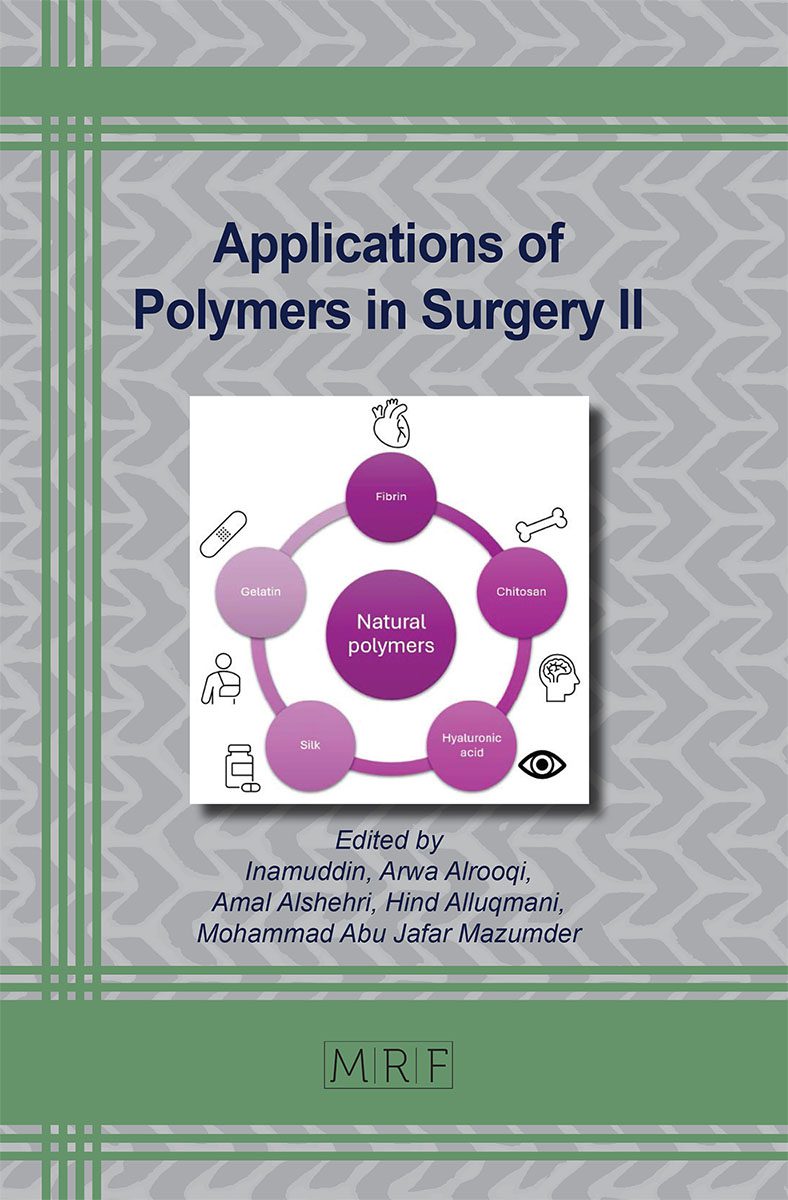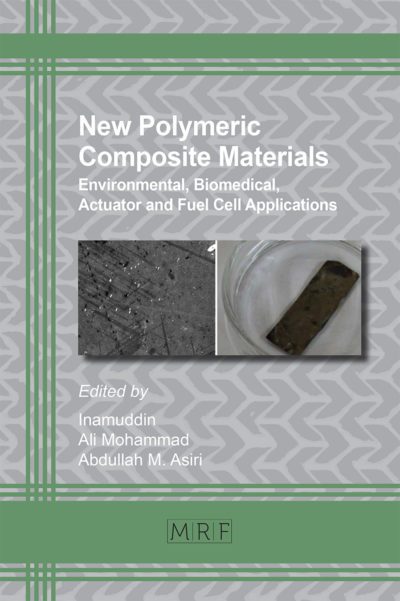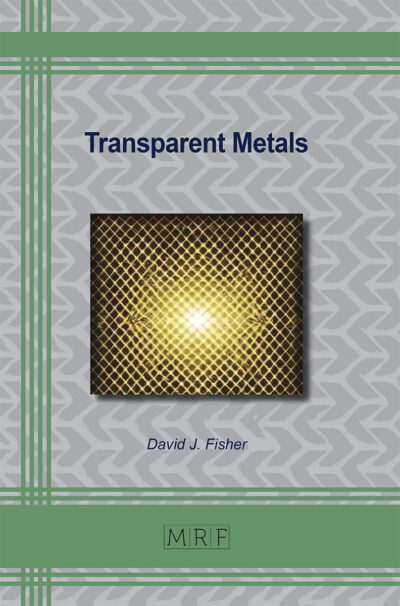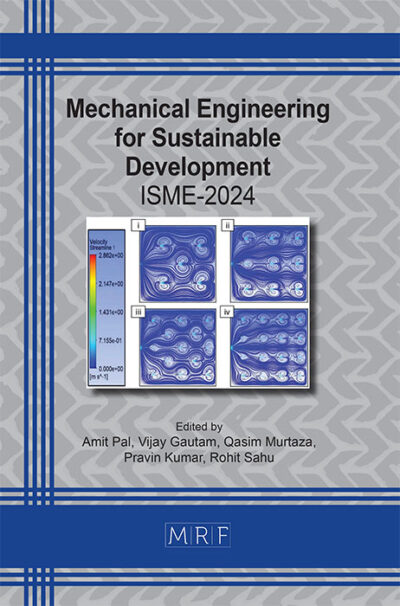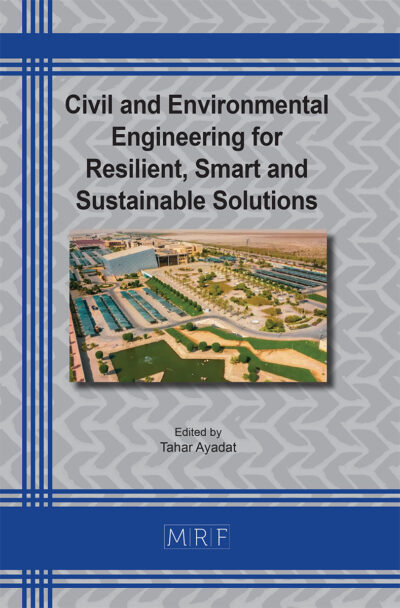Polymers in Wound Care and Dressings
Ingrid Larissa da Silva Soares, Maria Júlia Araújo Dias, Alessandra Teixeira, Mariana Rillo Sato, João Augusto Oshiro-Júnior
Polymers, both of natural and synthetic origin, have been essential in the evolution of chronic and acute wound healing and tissue regeneration, thanks to their unique and adaptable properties. Their applicability covers a wide range of areas, including industry. Biopolymers such as alginate, chitosan and cellulose are valued for their biocompatibility and ability to form gels, promoting favorable conditions for wound healing. However, their rapid degradation and limited mechanical resistance are disadvantages that can be overcome by combining them with synthetic polymers. Thus, synthetic polymers such as PVA, PLA and polyurethane offer greater structural stability, as well as allowing controlled drug release. In addition, hybrid polymers are emerging as innovative materials with improved absorption properties, mechanical resistance and antimicrobial functionalities, essential for the development of dressings, membranes, films and ova. This chapter covers the characteristics and applications of the main polymers, highlighting the most recent scientific and market contributions that act in the treatment of complex wounds, bone regeneration, as well as in the control of inflammatory and infectious processes.
Keywords
Smart Materials, Biocompatible Membrane, Wound Healing, Occlusive Dressings, Hydrocolloid
Published online 2/15/2025, 17 pages
Citation: Ingrid Larissa da Silva Soares, Maria Júlia Araújo Dias, Alessandra Teixeira, Mariana Rillo Sato, João Augusto Oshiro-Júnior, Polymers in Wound Care and Dressings, Materials Research Foundations, Vol. 172, pp 282-298, 2025
DOI: https://doi.org/10.21741/9781644903353-12
Part of the book on Applications of Polymers in Surgery II
References
[1] Aulton ME, Taylor KMG. Delineation_of_Pharmaceutical. 4th ed. Vol. 4, GEN Guanabara Koogan. Rio de Janeiro: Elsevier, 2; 2016. 872 páginas.
[2] Eriksson E, Liu PY, Schultz GS, Martins‐Green MM, Tanaka R, Weir D, et al. Chronic wounds: Treatment consensus. Wound Repair and Regeneration. 2022 Mar 7;30(2):156-71. https://doi.org/10.1111/wrr.12994
[3] Firlar I, Altunbek M, McCarthy C, Ramalingam M, Camci-Unal G. Functional Hydrogels for Treatment of Chronic Wounds. Gels. 2022 Feb 17;8(2):127. https://doi.org/10.3390/gels8020127
[4] Mota FAR, Passos MLC, Santos JLM, Saraiva MLMFS. Comparative analysis of electrochemical and optical sensors for detection of chronic wounds biomarkers: A review. Biosens Bioelectron. 2024 May;251:116095. https://doi.org/10.1016/j.bios.2024.116095
[5] Dong R, Guo B. Smart wound dressings for wound healing. Nano Today. 2021 Dec;41:101290. https://doi.org/10.1016/j.nantod.2021.101290
[6] Gruppuso M, Turco G, Marsich E, Porrelli D. Polymeric wound dressings, an insight into polysaccharide-based electrospun membranes. Appl Mater Today. 2021 Sep;24:101148. https://doi.org/10.1016/j.apmt.2021.101148
[7] Gruppuso M, Turco G, Marsich E, Porrelli D. Polymeric wound dressings, an insight into polysaccharide-based electrospun membranes. Appl Mater Today. 2021 Sep;24:101148. https://doi.org/10.1016/j.apmt.2021.101148
[8] Alven S, Peter S, Mbese Z, Aderibigbe BA. Polymer-Based Wound Dressing Materials Loaded with Bioactive Agents: Potential Materials for the Treatment of Diabetic Wounds. Polymers (Basel). 2022 Feb 14;14(4):724. https://doi.org/10.3390/polym14040724
[9] Aderibigbe BA. Hybrid-Based Wound Dressings: Combination of Synthetic and Biopolymers. Polymers (Basel). 2022 Sep 12;14(18):3806. https://doi.org/10.3390/polym14183806
[10] Ahmed S, Sharma P, Bairagi S, Rumjit NP, Garg S, Ali A, et al. Nature-derived polymers and their composites for energy depository applications in batteries and supercapacitors: Advances, prospects and sustainability. J Energy Storage. 2023 Aug;66:107391. https://doi.org/10.1016/j.est.2023.107391
[11] Silva ACQ, Silvestre AJD, Vilela C, Freire CSR. Natural Polymers-Based Materials: A Contribution to a Greener Future. Molecules. 2021 Dec 24;27(1):94. https://doi.org/10.3390/molecules27010094
[12] Eichhorn SJ, Gandini A. Materials from Renewable Resources. MRS Bull. 2010 Mar 31;35(3):187-93. https://doi.org/10.1557/mrs2010.650
[13] Bouhlouli M, Pourhadi M, Karami F, Talebi Z, Ranjbari J, Khojasteh A. Applications of Bacterial Cellulose as a Natural Polymer in Tissue Engineering. ASAIO Journal. 2021 Jul 11;67(7):709-20. https://doi.org/10.1097/MAT.0000000000001356
[14] Matei E, Predescu AM, Râpă M, Țurcanu AA, Mateș I, Constantin N, et al. Natural Polymers and Their Nanocomposites Used for Environmental Applications. Nanomaterials. 2022 May 17;12(10):1707. https://doi.org/10.3390/nano12101707
[15] Sanfelice, R. C., Pavinatto, A., Correa, D., & Correa, D. S. (2022). Nanotechnology applied to polymers.
[16] Kiiskinen J, Merivaara A, Hakkarainen T, Kääriäinen M, Miettinen S, Yliperttula M, et al. Nanofibrillar cellulose wound dressing supports the growth and characteristics of human mesenchymal stem/stromal cells without cell adhesion coatings. Stem Cell Res Ther. 2019 Dec 23;10(1):292. https://doi.org/10.1186/s13287-019-1394-7
[17] Matei E, Predescu AM, Râpă M, Țurcanu AA, Mateș I, Constantin N, et al. Natural Polymers and Their Nanocomposites Used for Environmental Applications. Nanomaterials. 2022 May 17;12(10):1707. https://doi.org/10.3390/nano12101707
[18] Aranaz I, Alcántara AR, Civera MC, Arias C, Elorza B, Heras Caballero A, et al. Chitosan: An Overview of Its Properties and Applications. Polymers (Basel). 2021 Sep 24;13(19):3256. https://doi.org/10.3390/polym13193256
[19] Luo Y, Cui L, Zou L, Zhao Y, Chen L, Guan Y, et al. Mechanically strong and on-demand dissoluble chitosan hydrogels for wound dressing applications. Carbohydr Polym. 2022 Oct;294:119774. https://doi.org/10.1016/j.carbpol.2022.119774
[20] Liu H, Chen R, Wang P, Fu J, Tang Z, Xie J, et al. Electrospun polyvinyl alcohol-chitosan dressing stimulates infected diabetic wound healing with combined reactive oxygen species scavenging and antibacterial abilities. Carbohydr Polym. 2023 Sep;316:121050. https://doi.org/10.1016/j.carbpol.2023.121050
[21] Pires ALR, Bierhalz ACK, Moraes ÂM. BIOMATERIALS: TYPES, APPLICATIONS, AND MARKET. Quim Nova. 2015; https://doi.org/10.5935/0100-4042.20150094
[22] Garcia T de F, Silva PGA, Barcelos BJ, Miranda M das GR de, Alonso C da S, Abreu MNS, et al. Criteria to evaluate the quality of alginate wound dressings. Rev Bras Enferm. 2021;74(4). https://doi.org/10.1590/0034-7167-2020-1091
[23] Chitrambalam TG, Christopher PJ, Sundaraj J, Paladugu R, Selvamuthukumaran S. Comparison of Efficacy of Alginate Filler Dressings with Conventional Saline Dressings for Cavity Wounds in Diabetic Foot Ulcer- A Prospective Cohort Study. JOURNAL OF CLINICAL AND DIAGNOSTIC RESEARCH. 2020;14(12):1-1. https://doi.org/10.7860/JCDR/2020/46448.14221
[24] Barros NR, Ahadian S, Tebon P, Rudge MVC, Barbosa AMP, Herculano RD. Highly absorptive dressing composed of natural latex loaded with alginate for exudate control and healing of diabetic wounds. Materials Science and Engineering: C. 2021 Feb;119:111589. https://doi.org/10.1016/j.msec.2020.111589
[25] Prete S, Dattilo M, Patitucci F, Pezzi G, Parisi OI, Puoci F. Natural and Synthetic Polymeric Biomaterials for Application in Wound Management. J Funct Biomater. 2023 Sep 3;14(9):455. https://doi.org/10.3390/jfb14090455
[26] Terzopoulou Z, Zamboulis A, Koumentakou I, Michailidou G, Noordam MJ, Bikiaris DN. Biocompatible Synthetic Polymers for Tissue Engineering Purposes. Biomacromolecules. 2022 May 9;23(5):1841-63. https://doi.org/10.1021/acs.biomac.2c00047
[27] Chin AL, Wang X, Tong R. Aliphatic Polyester‐Based Materials for Enhanced Cancer Immunotherapy. Macromol Biosci. 2021 Jul 28;21(7). https://doi.org/10.1002/mabi.202100087
[28] Barros RM. Polymers in Guided Bone Regeneration. In 2022. p. 195-215. https://doi.org/10.21741/9781644901892-8
[29] Vázquez N, Sánchez-Arévalo F, Maciel-Cerda A, Garnica-Palafox I, Ontiveros-Tlachi R, Chaires-Rosas C, et al. Influence of the PLGA/gelatin ratio on the physical, chemical and biological properties of electrospun scaffolds for wound dressings. Biomedical Materials. 2019 May 3;14(4):045006. https://doi.org/10.1088/1748-605X/ab1741
[30] Stepanova M, Korzhikova-Vlakh E. Modification of Cellulose Micro- and Nanomaterials to Improve Properties of Aliphatic Polyesters/Cellulose Composites: A Review. Polymers (Basel). 2022 Apr 5;14(7):1477. https://doi.org/10.3390/polym14071477
[31] Ciftci F, Ayan S, Duygulu N, Yilmazer Y, Karavelioglu Z, Vehapi M, et al. Selenium and clarithromycin loaded PLA-GO composite wound dressings by electrospinning method. International Journal of Polymeric Materials and Polymeric Biomaterials. 2022 Aug 13;71(12):898-909. https://doi.org/10.1080/00914037.2021.1925276
[32] Saraiva MM, Campelo M da S, Câmara Neto JF, Lima ABN, Silva G de A, Dias AT de FF, et al. Alginate/polyvinyl alcohol films for wound healing: Advantages and challenges. J Biomed Mater Res B Appl Biomater. 2022 Jan 12;111(1):220-33. https://doi.org/10.1002/jbm.b.35146
[33] Barros Araújo CB, da Silva Soares IL, da Silva Lima DP, Barros RM, de Lima Damasceno BPG, Oshiro-Junior JA. Polyvinyl Alcohol Nanofibers Blends as Drug Delivery System in Tissue Regeneration. Curr Pharm Des. 2023 Apr;29(15):1149-62. https://doi.org/10.2174/1381612829666230508144912
[34] Prete S, Dattilo M, Patitucci F, Pezzi G, Parisi OI, Puoci F. Natural and Synthetic Polymeric Biomaterials for Application in Wound Management. J Funct Biomater. 2023 Sep 3;14(9):455. https://doi.org/10.3390/jfb14090455
[35] Lustig A, Alves P, Call E, Santamaria N, Gefen A. The sorptivity and durability of gelling fibre dressings tested in a simulated sacral pressure ulcer system. Int Wound J. 2020 Apr 25;18(2):194-208. https://doi.org/10.1111/iwj.13515
[36] Bahadoran M, Shamloo A, Nokoorani YD. Development of a polyvinyl alcohol/sodium alginate hydrogel-based scaffold incorporating bFGF-encapsulated microspheres for accelerated wound healing. Sci Rep. 2020 Apr 30;10(1):7342. https://doi.org/10.1038/s41598-020-64480-9
[37] Fraga GN, Dragunski DC, Vilsinski BH, da Silva Azevedo CK, Wiggers HJ, Faria MGI, et al. Dressings produced from PVA nanofibers containing chloramphenicol. Colloids Surf A Physicochem Eng Asp. 2023 Oct;674:131760. https://doi.org/10.1016/j.colsurfa.2023.131760
[38] Das A, Mahanwar P. A brief discussion on advances in polyurethane applications. Advanced Industrial and Engineering Polymer Research. 2020 Jul;3(3):93-101. https://doi.org/10.1016/j.aiepr.2020.07.002
[39] de Souza FM, Kahol PK, Gupta RK. Introduction to Polyurethane Chemistry. In 2021. p. 1-24. https://doi.org/10.1021/bk-2021-1380.ch001
[40] Li S, Zhang Y, Ma X, Qiu S, Chen J, Lu G, et al. Antimicrobial Lignin-Based Polyurethane/Ag Composite Foams for Improving Wound Healing. Biomacromolecules. 2022 Apr 11;23(4):1622-32. https://doi.org/10.1021/acs.biomac.1c01465
[41] Khodabakhshi D, Eskandarinia A, Kefayat A, Rafienia M, Navid S, Karbasi S, et al. In vitro and in vivo performance of a propolis-coated polyurethane wound dressing with high porosity and antibacterial efficacy. Colloids Surf B Biointerfaces. 2019 Jun;178:177-84. https://doi.org/10.1016/j.colsurfb.2019.03.010
[42] Jena KK, Narayan R, Alhassan SM. Highly branched graphene siloxane−polyurethane-urea (PU-urea) hybrid coatings. Prog Org Coat. 2017 Oct;111:343-53. https://doi.org/10.1016/j.porgcoat.2017.06.020
[43] Clinical Trials. Assessment of Wound Closure Comparing Synthetic Hybrid-Scale Fiber Matrix With Standard of Care in Treating Diabetic Foot Ulcers (DFU) and With Living Cellular Skin Substitute in Treating Venous Leg Ulcers (VLU). https://clinicaltrials.gov/study/NCT04927702?tab=results, 2024 (accessed 01 september).
[44] Oshiro Junior JA, Mortari GR, de Freitas RM, Marcantonio-Junior E, Lopes L, Spolidorio LC, et al. Assessment of biocompatibility of ureasil-polyether hybrid membranes for future use in implantodontology. International Journal of Polymeric Materials and Polymeric Biomaterials. 2016 Sep 2;65(13):647-52. https://doi.org/10.1080/00914037.2016.1157796
[45] Oshiro JA, Scardueli CR, de Oliveira GJPL, Marcantonio RAC, Chiavacci LA. Development of ureasil-polyether membranes for guided bone regeneration. Biomed Phys Eng Express. 2017 Jan 31;3(1):015019. https://doi.org/10.1088/2057-1976/aa56a6
[46] Oshiro‐Junior JA, Barros RM, Silva CG, Souza CC, Scardueli CR, Marcantonio CC, et al. In vivo effectiveness of hybrid membranes with osteogenic growth peptide for bone regeneration. J Tissue Eng Regen Med. 2021 Aug 3;15(8):722-31. https://doi.org/10.1002/term.3226
[47] da Silva CG, Monteiro JR, Oshiro-Júnior JA, Chiavacci LA. Hybrid Membranes of the Ureasil-Polyether Containing Glucose for Future Application in Bone Regeneration. Pharmaceutics. 2023 May 12;15(5):1474. https://doi.org/10.3390/pharmaceutics15051474
[48] da Fonsêca NF, de Oliveira Alves-Júnior J, de Oliveira GD, Costa KMN, de Melo DF, Rolim Neto PJ, et al. Modified release of D-glucose incorporated into laponite/ureasil-poly(ethylene oxide) hybrid nanocomposite. J Solgel Sci Technol. 2024 Jun 10;110(3):705-19. https://doi.org/10.1007/s10971-024-06387-9
[49] Silva JA; AAC; SMSR, DBPGL, MACD. Cutaneous drug delivery: challenges and strategies for the development of transdermal formulations. Journal of Basic and Applied Pharmaceutical Sciences. 2010 Sep;31(3):125-31.
[50] Oshiro Junior JA, Carvalho FC, Soares CP, Chorilli M, Chiavacci LA. Development of Cutaneous Bioadhesive Ureasil-Polyether Hybrid Films. Int J Polym Sci. 2015;2015:1-7. https://doi.org/10.1155/2015/727324
[51] Araújo CBB, Alves Júnior J de O, Sato MR, Costa KMN, Lima JR, Damasceno BPG de L, et al. The Development and Pre-Clinical Anti-Inflammatory Efficacy of a New Transdermal Ureasil-Polyether Hybrid Matrix Loaded with Flavonoid-Rich Annona muricata Leaf Extract. Pharmaceutics. 2024 Aug 21;16(8):1097. https://doi.org/10.3390/pharmaceutics16081097
[52] Bezerra BMS, y Araújo SED de M, Alves-Júnior J de O, Damasceno BPG de L, Oshiro-Junior JA. The Efficacy of Hybrid Vaginal Ovules for Co-Delivery of Curcumin and Miconazole against Candida albicans. Pharmaceutics. 2024 Feb 23;16(3):312. https://doi.org/10.3390/pharmaceutics16030312

